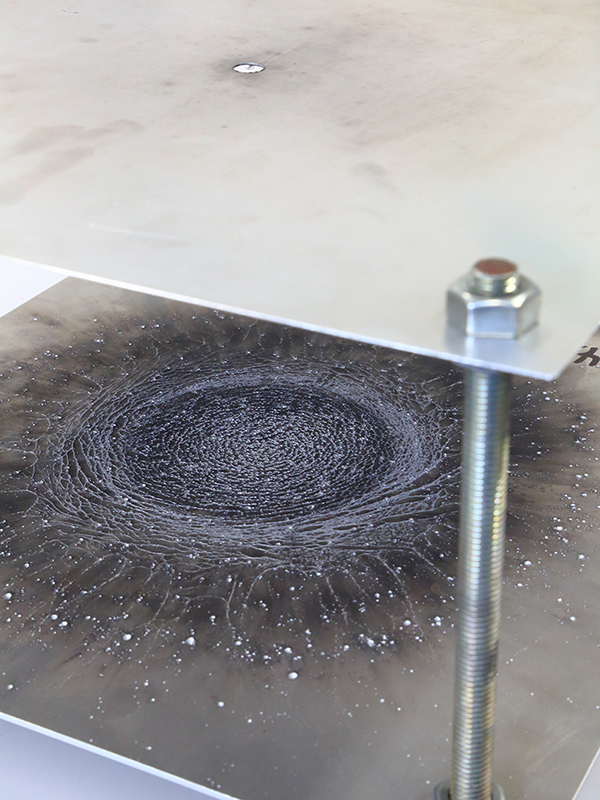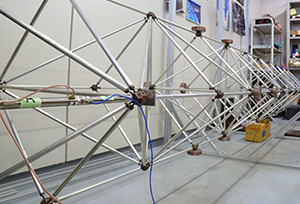
− Dr. Makihara, your field covers use of energy-harvesting and motion control systems in the space environment. For this you make use of "Smart Materials" like PZT** that exhibit piezoelectric effects. But you utilize other types of Smart Materials as well, like color-changing and "shape memory" products, in order to diagnose and "self-repair" damaged space structures. This means opening up ways to deal with damages from space debris*** in-flight. Can you tell us more about this?

Dr. Makihara: Yes, today I brought along a cross-section of the International Space Station (ISS) hull which we used for experimentation. The outer portion has been pierced by a debris but the inner portion is intact. ISS is located in Earth's orbit which is peppered with discarded items, a clear and present danger to space development. I was able to, through connections made with other university scientists while working on a JAXA project, apply their research results for damage diagnosis. The color changes due to monochromism are seen realizing easy diagnosis through visual observations.
Dr. Asai: That is quite interesting, because I am also using "color change" in my research. In my case the research focuses on measurement and flow simulation as used in aerodynamics. I conduct aerodynamic experiments using several unique wind-tunnel facilities. These not only include the Low-Turbulence Wind Tunnel at the Institute of Fluid Science, but also the world's only "Mars Wind Tunnel" (MWT). However, I also use advanced optical measurement techniques like pressure-sensitive paint, temperature-sensitive paint and fluorescent oil-film skin-friction meters as part of our studies of aerospace systems.
Dr. Ando: My research covers plasma science and technology, is related with Dr. Asai's research regarding space vehicle and aircraft surface improvements. Plasma can be used to "coat" the surface and also to see how the outer portion can be altered in response to changes in environmental conditions. I've been told my work on Magneto-Hydro-Dynamics (MHD) in plasmas and electric thrusters utilizing plasma, which can carry human and materials to Mars, is well known, which I find flattering. I am also involved in development of plasma diagnostics and applications in nano-, bio- and enviro-technologies as well. By the way, I would like to note that Dr. Asai is keenly interested in biomimetics due to his Mars airplane work too.
Dr. Asai: I aim to help develop a "Mars airplane" which can fly under thin atmospheric conditions like those found on Mars, our nearest planetary neighbor. I am proud to be using our MWT for this purpose. Yet the fact is that earthly creatures such as insects provide hints to Mars airplane designs, for example the dragonfly or the butterfly. We have adopted an approach different from NASA's where its Mars exploration project is designed for a ground-hugging robot dubbed "Curiosity" to scrutinize Mars surface. We can facilitate the effort by using the Mars airplane in transporting the probes quickly and to distant locations on the surface. As an aside, I have found many Earth-bound creatures to be hint-providers as well, as they live in an environment where viscous force make life "sticky" to say the least.
− Speaking of sticking points, how will the rover and the airplane be powered? The batteries and solar panels can be a real burden on the mission, no? The batteries are heavy while the panels can be prone to failure, are they not?
Dr. Makihara: Vibrations in space come and go throughout the structure since there is nothing to absorb them, leading to stress and eventual failure of the structure. To overcome this problem, I developed a digital self-powered circuit which suppresses such vibration. I advanced this invention to yield a complementary system to harvest energy at the same time as suppressing these vibrations. Hopefully my research will come in handy for work on Mars also, as energy-harvesting and Smart Materials are applicable to distantly-located systems, beyond easy repair. Self-propelled mechatronic systems can be powered and maintained in such situations. Energy harvesting also dispenses with the need to send heavy items to Mars, cutting down costs.

− Yes, I believe you noted after your invention was unveiled that "battery-less" systems will appear on Earth soon in the near future, as "wearable devices" generating its own power.
Of course, for Mars and other distant locations in space we need to reach them, and that is where Dr. Ando's work becomes crucial.
Dr. Ando: The space environment is a violent one. There are prominent MHD phenomena like anomalous heating in a solar corona, magnetic reconnection in the Earth magneto-tail accompanied by a powerful aurora and more. Strong irradiation of cosmic ray is harmful to human body. Propulsion using electrical energy and plasma in space enables us to reach Mars and return to Earth within a year. For example, ion engines and Hall-effect thrusters can be used for interstellar transport, but more powerful plasma thrusters are necessary to realize this transport system.
**PZT: Acronym for lead zirconate titanate, one of the most common "piezoelectric device ingredients"; the ceramic material can be used to produce items that act as an electric power generator ("piezoelectric effect") as well as an actuator ("inverse piezoelectric effect").
***Space debris: Also known as "orbital debris" usually pertain to defunct items such as spent rocket parts and obsolete satellites. Found in "space," i.e., the area beyond 100km line above sea level in altitude, waste materials large and small can include those less than 1cm in size are orbiting Earth.




